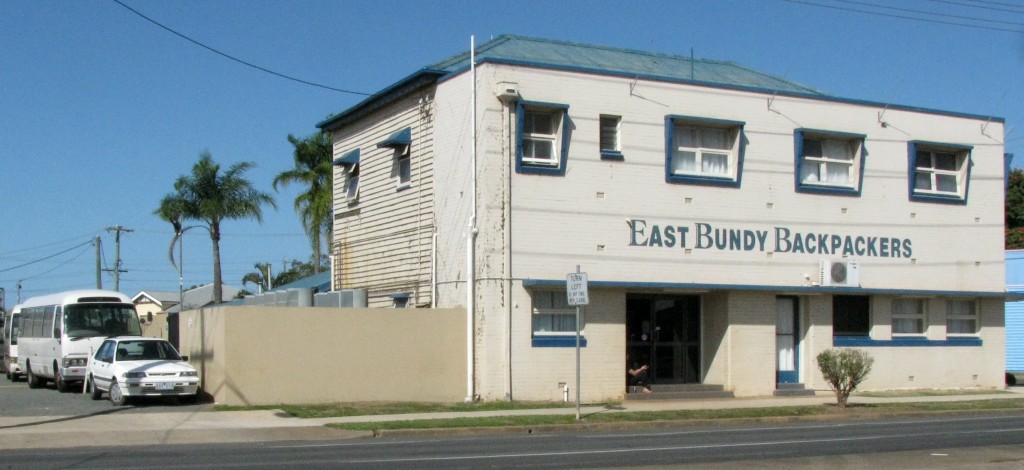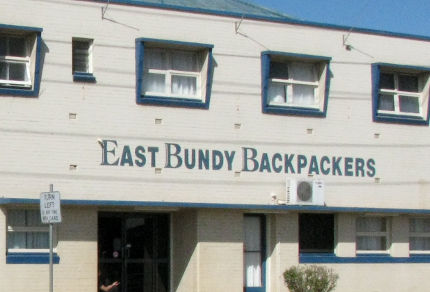Frustrated with five weeks of unsuccessful job hunting in Townsville and via contacting cattle stations and fruit and vegetable farms throughout eastern Queensland, Janis decided yesterday to go the route taken by many young travellers in Australia – that of checking into a backpackers’ lodge in an area needing harvesters. After many telephone inquiries, from which he learned that much of Queensland is having a slow season with poor crops, he settled on Bundaberg, a prime market gardening location near the coast in southeastern Queensland about 1000 kilometres south of Townsville. Bundaberg or ‘Bundy’ is surrounded not only by market gardens, but by vast plantations of sugarcane and is famous for its rum (with a polar bear on the label – go figure; my Canadian sensibilities shouted How dare they?). The southeast Queensland town also lies within a 20-minute drive of surfing beaches.
Having booked a room at East Bundy Backpackers for tonight and hoping to start work tomorrow, Janis needed a quick trip to Bundaberg. So he, Vilis, and I piled into the Kia early this morning, the car filled with food and such for Janis and camping gear for Vilis and me. Since our travel route would pass near Eungella National Park, famous for its platypus watching, Vilis and I decided to check out the park as part of our return trip to Townsville.
South of Townsville, mangoes bloomed in orchards, making me wonder what the mangoes I see around Townsville will look like in November, when big, ripe fruits adorn their branches. Around the orchards, tropical savannah woodland with understory grasses in shades of gold and rust stretched away into the distance. Overhead, black kites patrolled the Bruce Highway, and sulphur-crested cockatoos flocked into trees at the base of rocky hills to the west. Roadkilled macropods littered the highway edges, and a vast wetland with exposed sand plains reminiscent of the Townsville Town Common Conservation Park stretched away toward the coast.
Farther south, we entered sugarcane country, a broad plain covered with blocks of cane fields at various stages of maturity, which, if I employed an exaggerated vertical stretch of my imagination, bore some resemblance to the grain fields of the Canadian Prairies where I spent my childhood. Fields of young cane sprouting from neatly furrowed rows lay adjacent to mature fields, while fallow fields offered foraging grounds for ibises and magpie geese. South of Ayr, we crossed the Burdekin River, a vast expanse of sand at least 500 metres across threaded by cords of water. It was the Burdekin and its raging torrents impassable to cattle droves during the Wet that led to Townsville’s establishment in 1864 as an alternative port to Bowen, which lies south of the river. Beyond the river, wire-cage rail cars loaded with harvested cane formed long lines at the Inkerman Sugar Mill.
Gradually, the cane fields gave way to rangeland with the names of cattle stations at the roadside, and hazy peaks far in the distance. As we continued south, the rangleland, in turn, broke into a collage of mango orchards, market gardens, pastures, and woodland. Beyond Proserpine, cattle egrets rode the backs of red cattle, and a pair of brolgas or Australian cranes shared the same pasture. Beyond Mackay, macadamia orchards caught our attention in a landscape otherwise dominated by sugarcane and wooded rangeland. South of Rockhampton, darkness drifted down onto us, and we drove beneath a star-studded sky south, seemingly endlessly south toward Bundaberg. Thirteen hours after leaving Townsville, Janis checked into East Bundy Backpackers. The next phase of his Australian adventure was about to begin.

East Bundy Backpackers in Bundaberg (© Vilis Nams)


